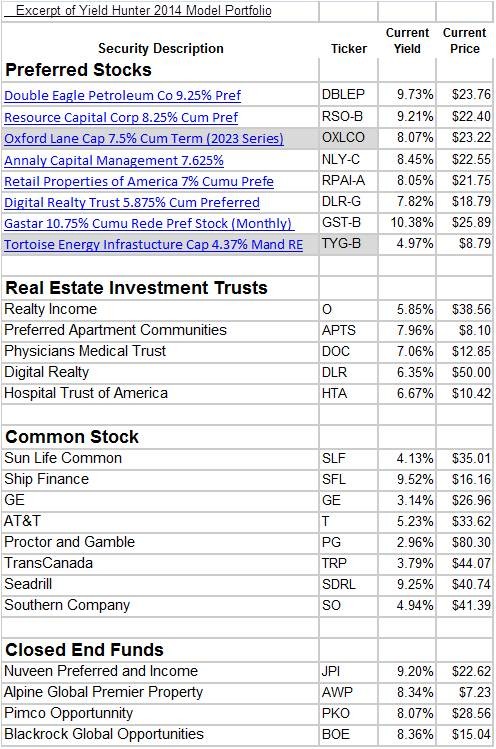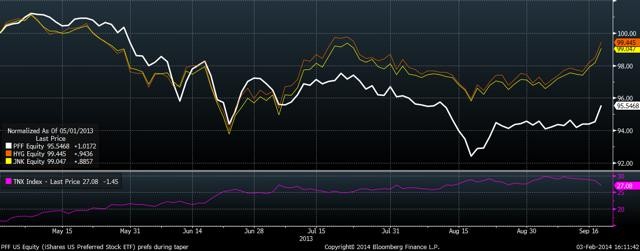Preferred stocks still make sense for yield
Post on: 2 Май, 2015 No Comment

Analysis & Opinion
CHICAGO (Reuters) — Frustrated yield seekers have been drawn to preferred stocks because they offer a several-point yield advantage over most U.S. investment grade bonds, including Treasuries, corporates and municipal bonds.
But these quasi-stock, quasi-bond investments act like bonds when interest rates rise: They fall in value. That has brought them some negative attention in the last few months. Preferred stocks declined in value as investors scrambled to find higher-yielding vehicles when rates rose. They may now may be oversold and offer some bargains.
Preferreds straddle a territory between common stocks and bonds. Mostly issued by financial companies, preferred stocks confer no voting rights, but represent a higher claim on earnings than common stocks, and are less volatile.
They also best the stock market’s dividend yield by a hefty amount: The Standard & Poor’s 500 stock index has a 2.01 percent dividend yield, while an exchange traded fund that holds the preferred shares of the same companies is yielding 5.78 percent.
In the event of a company’s liquidation, preferred stockholders are second in line for corporate assets, behind bond investors. Buying a pool of preferreds through exchange-traded funds can help you mitigate that risk.
The largest preferred-stock exchange-traded fund — the $10 billion iShares S&P Preferred Stock Index — lost nearly 7 percent in the three months through August 16. It charges 0.48 percent annually for management expenses, and holds shares from megabanks such as Barclays Bank plc, Citigroup and Wells Fargo & Co.
Due to its nearly 6 percent yield, the iShares fund still keeps you slightly ahead of the bond market’s recent volatility. It’s up 0.25 percent over the 12 months through August 16. By comparison, the Barclays U.S. Aggregate Bond Total Return Index, a benchmark for the U.S. bond market, which is down nearly 2 percent.
The main issue with preferred stocks is interest-rate risk, says Eric Dutram, an analyst with Zacks Investment Research in Chicago. There’s no way around it.
MORE DIVERSIFIED ALTERNATIVES
Still, it’s vexing to see a high-yield stock track the bond market. In a perfect world, that wouldn’t happen and a preferred stock would offer a diversified option to high-yield bonds.
One way to sidestep some of the volatility is to invest in preferreds outside of U.S. financial services, which have been soaring over the past year. The sector has rebounded strongly from the post-2008 selloff and is up more than 32 percent in the 12 months ending August 16, but may have run its course.
A worthy option is the Global X SuperIncome Preferred ETF, which holds non-U.S. companies such as HSBC Holdings, plc, Royal Bank of Scotland Group plc and Lloyds Banking Group plc. The fund is up almost 4 percent for the 12 months through August 16 and yields nearly 7 percent. It also costs more to manage: 0.65 percent annually.

Keep in mind that preferreds have yet another advantage that somewhat offsets their close correlation to bonds: They are less volatile than common stocks. When the S&P 500 fell 37 percent in 2008, for example, the iShares preferred fund fell only 24 percent.
That doesn’t mean you should gorge on the high yields that preferreds offer and abandon common stocks. Preferred funds are heavily concentrated in the financial sector, which adds another layer of diversification risk. You can always buy individual preferred issues, but they are complicated to analyze, so you may want to use an experienced adviser who knows how to buy them at a good price.
You’ll still need to balance out the income side of your portfolio with vehicles such as municipal, government and corporate bonds and real estate investment trusts.
Every one of these investments can lose value in a rising-rate environment, so they may still hold some nasty surprises if the economy keeps heating up and the Federal Reserve starts to back off its monetary easing policy.
(The author is a Reuters columnist and the opinions expressed are his own.)
(Follow us @ReutersMoney or here Editing by Linda Stern and Phil Berlowitz)














